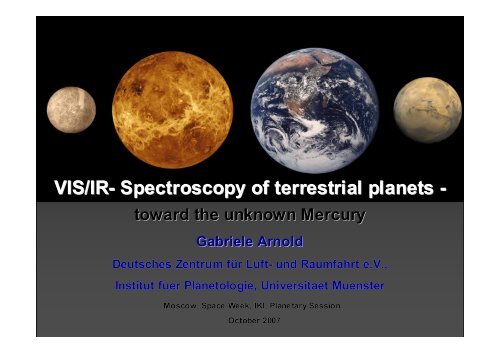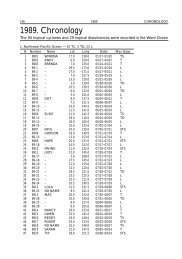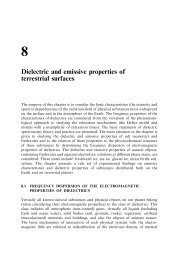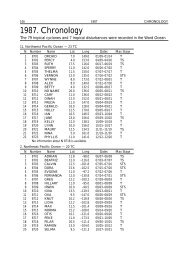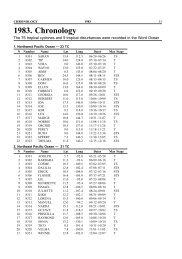VIS/IR- Spectroscopy of terrestrial planets -
VIS/IR- Spectroscopy of terrestrial planets -
VIS/IR- Spectroscopy of terrestrial planets -
Create successful ePaper yourself
Turn your PDF publications into a flip-book with our unique Google optimized e-Paper software.
<strong>VIS</strong>/<strong>IR</strong>- <strong>Spectroscopy</strong> <strong>of</strong> <strong>terrestrial</strong> <strong>planets</strong> -<br />
toward the unknown Mercury<br />
Gabriele Arnold<br />
Deutsches Zentrum für Luft- und Raumfahrt e.V.,<br />
Institut fuer Planetologie, Universitaet Muenster<br />
Moscow, Space Week, IKI, Planetary Session<br />
October 2007
Comparative planetology <strong>of</strong> the <strong>terrestrial</strong> <strong>planets</strong><br />
Goals<br />
• Studies <strong>of</strong> origin, evolution and state <strong>of</strong> <strong>terrestrial</strong> planetary<br />
bodies in the Solar system starting from the Solar nebula<br />
• Accretion processes (interior, core, crust, magnetic field and<br />
atmospheres) - initial processes, time lines, formation constrains<br />
• Comparative analysis!<br />
• Geology, chemical and physical properties <strong>of</strong> <strong>terrestrial</strong> <strong>planets</strong><br />
• Study <strong>of</strong> evolution prospects
Comparative planetology <strong>of</strong> the <strong>terrestrial</strong> <strong>planets</strong><br />
Comparison<br />
• Masses<br />
• Density<br />
• Structure<br />
and composition<br />
• Atmospheres<br />
• Evolution<br />
paths
Comparative planetology <strong>of</strong> the <strong>terrestrial</strong> <strong>planets</strong><br />
Comparison<br />
• Masses<br />
• Density<br />
• Structure and<br />
composition<br />
• Atmospheres<br />
• Evolution<br />
paths
Comparative planetology <strong>of</strong> the <strong>terrestrial</strong> <strong>planets</strong><br />
Comparison<br />
• Masses<br />
• Density<br />
• Structure and composition<br />
• Atmospheres<br />
• Evolution<br />
paths<br />
runaway greenhouse<br />
freezing<br />
T mean<br />
: 737 K 288 K 210 K<br />
Ρ: 92 bar 1 bar 0.0064 bar
Comparative planetology <strong>of</strong> the <strong>terrestrial</strong> <strong>planets</strong><br />
Evolution <strong>of</strong> <strong>terrestrial</strong> <strong>planets</strong> (formation models)<br />
• “planetesimal accretion” in the refractory inner part <strong>of</strong> the Solar system, inward <strong>of</strong> the<br />
ice line, located at a distance <strong>of</strong> about 3 AU for Sun-like stars (Marcy et al. 2005),<br />
“rubble piles” – km – size gravitational aggregates <strong>of</strong> indestructible particles<br />
(Leinhardt 2005)<br />
Proplyds surrounding new star onset, ice formation <strong>of</strong> runaway grow<br />
Borne stars in Orion nebula line moves inward planetesimals (NASA/JPL-Caltech)<br />
(NASA/C.R.O’Dell/Rice Univ.) (NASA/JPL-Caltech) (NASA/JPL-Caltech)
Comparative planetology <strong>of</strong> the <strong>terrestrial</strong> <strong>planets</strong><br />
Evolution <strong>of</strong> <strong>terrestrial</strong> <strong>planets</strong> (formation models)<br />
• “planetesimal accretion” in the refractory inner part <strong>of</strong> the Solar system, inward <strong>of</strong> the<br />
ice line, located at a distance <strong>of</strong> about 3 AU for Sun-like stars (Marcy et al. 2005),<br />
“rubble piles” – km – size gravitational aggregates <strong>of</strong> indestructible particles<br />
(Leinhardt 2005)<br />
• Mass grow <strong>of</strong> <strong>terrestrial</strong> <strong>planets</strong> with masses ranging from 0.06 up to 1 Earth mass<br />
appears to be more slowly compared to giant <strong>planets</strong> (Chambers 2001, Raymond et al.<br />
2006, Fogg and Nelson 2006)<br />
• “runaway grow” and formation <strong>of</strong> proto<strong>planets</strong> with diameters <strong>of</strong> several hundred<br />
kilometers inside a time line <strong>of</strong> about 10-30 million years (Su et al. 2006), depending<br />
on mass and metallicity <strong>of</strong> the primordial disk<br />
• “oligarchic grow” above a critical starting mass, in witch a small collection <strong>of</strong> objects<br />
accretes mass through collisions with less massive bodies (Raymond 2007)<br />
• “late heavy bombardment” from residual debris about 700 million years after<br />
commencement <strong>of</strong> planetesimal accretion (Gomes et al. 2005)
Comparative planetology <strong>of</strong> the <strong>terrestrial</strong> <strong>planets</strong><br />
Evolution <strong>of</strong> <strong>terrestrial</strong> <strong>planets</strong> (differentiation)<br />
• Differentiation (nucleus, core and crust) resulting from energy sources<br />
<strong>of</strong> accretion heat, radioactive decay and tidal forces<br />
• Endogenous processes:<br />
Mercury and Moon: heat lost primary by heat conduction without<br />
material movement, lithosphere grows to a single plate, surfaces<br />
characterized by high crater density<br />
Venus, Earth: heat lost primary by heat convection, resurfacing <strong>of</strong><br />
the initial crust by volcanism and tectonic processes<br />
Mars: intermediate state<br />
• Exogenous processes:<br />
Weathering, degradation, erosion, sedimentation<br />
• Composition: primary basaltic
Comparative planetology <strong>of</strong> the <strong>terrestrial</strong> <strong>planets</strong><br />
Open questions<br />
Evolution:<br />
What can we learn about thermo dynamical properties and transport <strong>of</strong><br />
material?<br />
How do material properties and structure determine the endogenous<br />
dynamics?<br />
What kind <strong>of</strong> mechanisms causing tectonic movements?<br />
How planetary magnetic fields developed?<br />
Surface formation processes:<br />
How crater impacts effect the planetary evolution?<br />
What teach us the surface morphology and composition about the<br />
endogenous processes?<br />
How differ the exogenous processes for each <strong>of</strong> the <strong>terrestrial</strong> <strong>planets</strong>?<br />
How the formation <strong>of</strong> the planetary atmospheres is determined with<br />
these processes?
Spectral remote sensing <strong>of</strong> <strong>terrestrial</strong> <strong>planets</strong><br />
Spectral studies in the visible and <strong>IR</strong> range<br />
• planetary atmospheres<br />
Composition, temperatures, dynamics, energy balance<br />
• planetary surfaces<br />
Surface composition (minerals, ices, organics)<br />
Surface texture<br />
Surface temperatures and thermal inertia<br />
Compositional mapping <strong>of</strong> geologic features<br />
Studies <strong>of</strong> regional and temporal dynamics
Spectral remote sensing <strong>of</strong> <strong>terrestrial</strong> <strong>planets</strong><br />
Early remote sensed deep space spectroscopy <strong>of</strong> <strong>terrestrial</strong> <strong>planets</strong> I<br />
Interferometry – orbital instruments<br />
Mariner 9, <strong>IR</strong>IS M – Mars (1972-73)<br />
Venera 15, 16 – Venus (1983)<br />
Mars Global Surveyor TES – Mars (1997 – 2001)<br />
Mars Express (MEX) PFS – Mars (since 2003)
Spectral remote sensing <strong>of</strong> <strong>terrestrial</strong> <strong>planets</strong><br />
Early remote sensed deep space spectroscopy <strong>of</strong> <strong>terrestrial</strong> <strong>planets</strong> I<br />
Interferometry – PMV on Venera 15 and 16<br />
Spectral band<br />
Spectral bandwidth<br />
with<br />
Field <strong>of</strong> view<br />
Recording time<br />
Area <strong>of</strong> aperture<br />
NER<br />
Orbit<br />
Apogee<br />
Cycle time<br />
Weight<br />
6.25 – 38 µm V15<br />
6.25 – 25 µm V16<br />
5 cm -1 (apodized)<br />
7.5 cm -1 (apodized,<br />
onboard FFT)<br />
4° x 4° (retangle)<br />
5.5 s<br />
8 cm -1 V15<br />
10 cm -1 V16<br />
2.5 10 -8 Wcm -1 sr<br />
highly elliptical<br />
850 km<br />
24 h<br />
25 kg<br />
Opto-mechanical part <strong>of</strong> PMV
Spectral remote sensing <strong>of</strong> <strong>terrestrial</strong> <strong>planets</strong><br />
Early remote sensed deep space spectroscopy <strong>of</strong> <strong>terrestrial</strong> <strong>planets</strong> I<br />
Interferometry – PMV on Venera 15 and 16<br />
Brightness temperature/ K<br />
Venus mid-<strong>IR</strong> spectra<br />
wave number/ cm -1
Spectral remote sensing <strong>of</strong> <strong>terrestrial</strong> <strong>planets</strong><br />
Remote sensed deep space spectroscopy <strong>of</strong> <strong>terrestrial</strong> <strong>planets</strong> I<br />
Interferometry – Planetary Fourier Spectrometer on MEX<br />
PFS is a two-channel Fourier transform spectrometer. Two channels indicate to<br />
spectrometers, one on top <strong>of</strong> the other one. Both are equipped with a pair <strong>of</strong> retroreflectors,<br />
i.e. three flat mirrors assembled to a corner <strong>of</strong> a cube. They are attached by brackets to an<br />
axle moved by a torque motor. This angular movement changes the path <strong>of</strong> difference.<br />
EM <strong>of</strong> PFS<br />
The optical performance <strong>of</strong> PFS
Spectral remote sensing <strong>of</strong> <strong>terrestrial</strong> <strong>planets</strong><br />
Remote sensed deep space spectroscopy <strong>of</strong> <strong>terrestrial</strong> <strong>planets</strong> I<br />
Interferometry – Planetary Fourier Spectrometer on MEX<br />
Mars:<br />
equator<br />
South polar water<br />
ice observation by<br />
PFS<br />
South pol<br />
wavenumber/ cm -1<br />
Quelle: Formisano V., PSF-CoI-Team, ESA
Spectral remote sensing <strong>of</strong> <strong>terrestrial</strong> <strong>planets</strong><br />
PFS-Surface temperature retrieval<br />
• Temperatures are derived in areas showing little or no spectral contrast<br />
• Using 2 areas allows an estimate on the error in the temperature retrieval<br />
Study area<br />
CO 2<br />
See also Helbert et al. 2005<br />
SBT1<br />
SBT2<br />
20-25µm<br />
25-33µm
Spectral remote sensing <strong>of</strong> <strong>terrestrial</strong> <strong>planets</strong><br />
PFS-Surface temperature retrieval<br />
• Temperatures are derived in areas showing little or no spectral contrast<br />
• Using 2 areas allows an estimate on the error in the temperature retrieval<br />
The surface temperature retrieval is the basis for the<br />
extraction <strong>of</strong> reflectance and emittance features in the<br />
transition range between the reflected solar and thermal<br />
emitted radiation <strong>of</strong> Mars (3 – 5 µm) adding information<br />
about tertiary weathering products (primary sulfates<br />
observed by Omega at shorter wavelengths).<br />
Study area<br />
CO<br />
Key information <strong>of</strong> exogenous processes in the climatic 2<br />
history <strong>of</strong> Mars – a <strong>terrestrial</strong> planet being in an intermediate<br />
evolution state compared to Venus and Mercury.<br />
SBT1<br />
SBT2<br />
20-25µm<br />
25-33µm
Spectral remote sensing <strong>of</strong> <strong>terrestrial</strong> <strong>planets</strong><br />
Remote sensed deep space spectroscopy <strong>of</strong> <strong>terrestrial</strong> <strong>planets</strong> II<br />
Imaging spectroscopy – orbital instruments<br />
Phobos 2 ISM – Mars (1989)<br />
{Mars Odyssey THEMIS – Mars (since 2002)}<br />
(V<strong>IR</strong>TIS Rosetta) – Mars flight by<br />
Mars Express (MEX) OMEGA - Mars (since 2003)<br />
Venus Express (VEX) V<strong>IR</strong>TIS – Venus (since 2006)<br />
Bepi Colombo (BC) MERTIS- Mercury
Spectral remote sensing <strong>of</strong> <strong>terrestrial</strong> <strong>planets</strong><br />
Remote sensed deep space spectroscopy <strong>of</strong> <strong>terrestrial</strong> <strong>planets</strong> II<br />
Imaging spectroscopy – orbital instruments<br />
Venus and Earth<br />
• Venus is only slightly smaller than Earth (95% <strong>of</strong> Earth‘s diameter,<br />
80% <strong>of</strong> Earth‘s mass).<br />
• Both have few craters indicating relatively young surfaces.<br />
• Their densities and chemical composition are similar.
Spectral remote sensing <strong>of</strong> <strong>terrestrial</strong> <strong>planets</strong><br />
Remote sensed deep space spectroscopy <strong>of</strong> <strong>terrestrial</strong> <strong>planets</strong> II<br />
Imaging spectroscopy – orbital instruments<br />
Venus surface<br />
• The surface <strong>of</strong> Venus presents<br />
clear evidence <strong>of</strong> violent<br />
volcanic activity in the past,<br />
including shield volcanoes<br />
similar to those on Earth.<br />
The eight-km high volcano Maat Mons, as recreated<br />
from Magellan data taken in 1991. Note the lava flows that<br />
extend hundred <strong>of</strong> km across the plains, NASA.<br />
Mead Crater<br />
– largest<br />
impact<br />
crater on<br />
Venus<br />
Mead Crater, 280 km in<br />
diameter, multi-ringed crater,<br />
Magellan, NASA.<br />
Unlike Moon, Mars and Mercury,<br />
Venus have relatively few small<br />
impact craters, but does have more<br />
medium to large craters. This is the<br />
result <strong>of</strong> the planet‘s dense<br />
atmosphere burning up smaller<br />
meteorites.
Spectral remote sensing <strong>of</strong> <strong>terrestrial</strong> <strong>planets</strong><br />
Remote sensed deep space spectroscopy <strong>of</strong> <strong>terrestrial</strong> <strong>planets</strong> II -<br />
Venus<br />
• Gently rolling plains with little relief.<br />
• Several broad depressions: Atalanta Planitia, Guinevere Planitia, Lavina<br />
Planitia.<br />
• Two large highlands: Ishtar Terra (northern hemisphere) and Aphrodite Terra<br />
(extends along the equator)<br />
3<br />
1<br />
2<br />
lowlands<br />
(20%)<br />
deposition<br />
plains, rolling<br />
hills (70%)<br />
highlands<br />
(10%)<br />
altimeter topography, Magellan, red- high, blue- low
Spectral remote sensing <strong>of</strong> <strong>terrestrial</strong> <strong>planets</strong><br />
Remote sensed deep space spectroscopy <strong>of</strong> <strong>terrestrial</strong> <strong>planets</strong> II<br />
Imaging spectroscopy – orbital instruments<br />
Open questions<br />
• Surface composition is unknown.<br />
• Lower atmosphere – mostly unexplored, interaction <strong>of</strong> atmosphere and<br />
surface mostly unknown, alteration processes <strong>of</strong> surface material vague<br />
• Are there signs for ongoing volcanic activity? Certain regions on Venus<br />
might be younger (Beta-Atla-Themis).<br />
• Could an early magnetic filed leave signatures?<br />
• Can we learn more about the pre-resurfacing period <strong>of</strong> Venus? Probably<br />
the climate history is more sensitive to answer this question?<br />
• Did Venus exhibit habitable conditions in the pre-resurfacing phase (2<br />
b.y ago)?<br />
• Will future Earth resemble Venus?
Spectral remote sensing <strong>of</strong> <strong>terrestrial</strong> <strong>planets</strong><br />
Remote sensed deep space spectroscopy <strong>of</strong> <strong>terrestrial</strong> <strong>planets</strong> II<br />
Imaging spectroscopy – orbital instruments - V<strong>IR</strong>TIS<br />
Radiance [W / (m2 sr µm)]<br />
0.20<br />
0.18<br />
0.16<br />
0.14<br />
0.12<br />
0.10<br />
0.08<br />
0.06<br />
0.04<br />
0.02<br />
1 2<br />
Orbit 47<br />
V<strong>IR</strong>TIS Night Side Radiances<br />
Lowlands (10-30°N)<br />
Lowlands (30-45°N)<br />
Maxwell Montes (65-70 °N)<br />
3<br />
4<br />
0.00<br />
1.0 1.1 1.2 1.3 1.4 1.5 1.6 1.7 1.8 1.9 2.0 2.1 2.2 2.3 2.4<br />
5<br />
Wavelength [µm]<br />
1<br />
2<br />
3<br />
4<br />
5<br />
6<br />
7<br />
ν[cm-1] λ[µm] z m<br />
[km]<br />
9800 1.02 0<br />
9200 1.09 0 - 5<br />
8500 1.18 5 -10<br />
7800 1.28 10-20<br />
5780 1.73 15-30<br />
4350 2.30 30-40<br />
2325 4.30 > 60<br />
z m : altitude <strong>of</strong> maximum<br />
inform at ion<br />
6<br />
Venus night side<br />
thermal emission: a<br />
key to study surface<br />
properties<br />
Surface window 1:<br />
radiances depend on<br />
elevation (temperature)<br />
Surface window 2+3:<br />
evidence <strong>of</strong> surface-deep<br />
atmosphere correlation<br />
Surface windows 4-6:<br />
latitudinal variations in<br />
the lower atmosphere
Spectral remote sensing <strong>of</strong> <strong>terrestrial</strong> <strong>planets</strong><br />
Venus Express<br />
V<strong>IR</strong>TIS:<br />
RT model: first<br />
simulations<br />
First results, application<br />
<strong>of</strong> a new RT-approach:<br />
The windows at 1.02 µm can be<br />
used for surface properties<br />
extraction.<br />
The improvement <strong>of</strong> RT models<br />
will allow to obtain quantitative<br />
information.<br />
The windows 2 ff will give us a<br />
better understanding <strong>of</strong> the<br />
chemistry <strong>of</strong> the lower<br />
atmosphere.<br />
Arnold et al.,<br />
EGU 2007
Spectral remote sensing <strong>of</strong> <strong>terrestrial</strong> <strong>planets</strong><br />
Venus Express<br />
V<strong>IR</strong>TIS:<br />
RT model: first<br />
simulations<br />
First results, application<br />
<strong>of</strong> a new RT-approach:<br />
The windows at 1.02 µm can be<br />
used for surface properties<br />
extraction.<br />
The improvement <strong>of</strong> RT models<br />
will allow to obtain quantitative<br />
information.<br />
The windows 2 ff will give us a<br />
better understanding <strong>of</strong> the<br />
chemistry <strong>of</strong> the lower<br />
atmosphere.<br />
Arnold et al.,<br />
EGU 2007
Spectral remote sensing <strong>of</strong> <strong>terrestrial</strong> <strong>planets</strong><br />
Topography analysis <strong>of</strong> northern highlands: V<strong>IR</strong>TIS-stray light<br />
correction, derivation <strong>of</strong> altitude by the 1.18/1.02 µm ratio<br />
Radiance ratio <strong>of</strong> 1.18-µm deep<br />
atmospheric window (10 km<br />
height) to the surface window<br />
at 1.02 µm<br />
Ishtar Terra<br />
elevation
Spectral remote sensing <strong>of</strong> <strong>terrestrial</strong> <strong>planets</strong><br />
V<strong>IR</strong>TIS<br />
observation<br />
strips<br />
Arnold et al.,<br />
EGU 2007
Spectral remote sensing <strong>of</strong> <strong>terrestrial</strong> <strong>planets</strong><br />
Beta<br />
Regio<br />
V<strong>IR</strong>TIS<br />
observation<br />
strips<br />
Arnold et al.,<br />
EGU 2007
Spectral remote sensing <strong>of</strong> <strong>terrestrial</strong> <strong>planets</strong><br />
Topographic correlation<br />
Surface and deep atmosphere physics<br />
Stray light correction.◄<br />
Radiance ratios 1.18/1.02 µm can be used to map the surface topography. ◄<br />
Deep atmospheric windows give us a better understanding <strong>of</strong> the chemistry <strong>of</strong> the<br />
lower atmosphere. ◄<br />
To first order, the surface temperature is a function <strong>of</strong> altitude. ◄<br />
Radiance ratio <strong>of</strong> 1.18-µm deep<br />
atmospheric window (10 km<br />
height) to the surface window<br />
at 1.02 µm<br />
V<strong>IR</strong>TIS should able to detect volcanism (lava flows <strong>of</strong> at least 1000K covering an<br />
area <strong>of</strong> about 20 km 2 ).<br />
The masking <strong>of</strong> atmospheric windows by wing absorptions <strong>of</strong> the deep<br />
atmosphere constituents requires detailed radiative transfer calculations<br />
including appropriate spectral line data basis and line pr<strong>of</strong>iles as well as multiple<br />
scattering effects due to the dense cloud deck.◄<br />
elevation<br />
Small derivations from the altitude dependence <strong>of</strong> surface temperature exist.<br />
Disentangle <strong>of</strong> atmospheric, emittance and temperature radiance contributions<br />
from the surface and in the deeper Venusians atmosphere may add new data<br />
about Venus surface material variations in global scales too?◄
Spectral remote sensing <strong>of</strong> <strong>terrestrial</strong> <strong>planets</strong><br />
Remote sensed deep space spectroscopy <strong>of</strong> <strong>terrestrial</strong> <strong>planets</strong> III<br />
Toward Mercury – M<strong>IR</strong>-Imaging spectroscopy<br />
Mercury and Earth<br />
• Mercury formed closest to the sun with only 0.06 <strong>of</strong> Earth's mass.<br />
• Mercury is characterized by high crater density indicating an old<br />
surface (45% <strong>of</strong> the surface have been imaged by Mariner 10).<br />
• Mercury shows a density anomaly.
Spectral remote sensing <strong>of</strong> <strong>terrestrial</strong> <strong>planets</strong><br />
Remote sensed deep space spectroscopy <strong>of</strong> <strong>terrestrial</strong> <strong>planets</strong> III<br />
Toward Mercury – M<strong>IR</strong>-Imaging spectroscopy<br />
From telescopic / spectroscopic observations<br />
1. Space weathered silicate material (SiO 2 –<br />
content varying between 39-57%, Sprague<br />
et al. 2007), heterogeneous composition<br />
2. Evidence for feldspatic expanses, glassy<br />
soil?, (Sprague and Roush 1998)<br />
3. Pyroxene spectral features at four locations<br />
(clino- and orthopyroxenes, Vilas et al.<br />
1984,85,88)<br />
4. Low FeO and TiO 2 content (Lucey et al.,<br />
1998, 2000)<br />
5. Little evidence for nanophase FeO, but<br />
containing some Fe 0<br />
6. Some evidence for no- ore low-iron alkali<br />
basalts and feldspathoides (Sprague et al.,<br />
2007)<br />
7. Structural and global dichromy<br />
(Ksanformality, 1998)
Spectral remote sensing <strong>of</strong> <strong>terrestrial</strong> <strong>planets</strong><br />
Remote sensed deep space spectroscopy <strong>of</strong> <strong>terrestrial</strong> <strong>planets</strong> III<br />
Toward Mercury – M<strong>IR</strong>-Imaging spectroscopy<br />
From telescopic / spectroscopic observations<br />
1. Space weathered silicate material (SiO 2 –<br />
content varying between 39-57%, Sprague<br />
et al. 2007), heterogeneous composition<br />
2. Evidence for feldspatic expanses, glassy<br />
soil?, (Sprague and Roush 1998)<br />
3. Pyroxene spectral features at four locations<br />
(clino- and orthopyroxenes, Vilas et al.<br />
1984,85,88)<br />
4. Low FeO and TiO 2 content (Lucey et al.,<br />
1998, 2000)<br />
5. Little evidence for nanophase FeO, but<br />
containing some Fe 0<br />
6. Some evidence for no- ore low-iron alkali<br />
basalts and feldspathoides (Sprague et al.,<br />
2007)<br />
7. Structural and global dichromy<br />
(Ksanformality, 1998)<br />
Sprague et al. 1998, 2006, 2007
Spectral remote sensing <strong>of</strong> <strong>terrestrial</strong> <strong>planets</strong><br />
Remote sensed deep space spectroscopy <strong>of</strong><br />
<strong>terrestrial</strong> <strong>planets</strong> III<br />
Toward Mercury – M<strong>IR</strong>-Imaging<br />
spectroscopy on Bepi Colombo<br />
MERTIS: Identify<br />
minerals<br />
Study <strong>of</strong> Mercury‘s surface<br />
composition<br />
Identification <strong>of</strong> rock-forming<br />
minerals<br />
Mapping <strong>of</strong> the surface mineralogy<br />
Study <strong>of</strong> surface temperature and<br />
thermal inertia<br />
Source: ESA
Spectral remote sensing <strong>of</strong> <strong>terrestrial</strong> <strong>planets</strong><br />
Remote sensed deep space spectroscopy <strong>of</strong> <strong>terrestrial</strong> <strong>planets</strong> III<br />
Toward Mercury – M<strong>IR</strong>-Imaging spectroscopy<br />
Mercury’s mid infrared radiance
Spectral remote sensing <strong>of</strong> <strong>terrestrial</strong> <strong>planets</strong><br />
Remote sensed deep space spectroscopy <strong>of</strong> <strong>terrestrial</strong> <strong>planets</strong> III<br />
Toward Mercury – M<strong>IR</strong>-Imaging spectroscopy<br />
1.0<br />
CF<br />
Anorthite<br />
Albite<br />
O rtho clase<br />
Emissivity<br />
0.9<br />
RB<br />
CF - Christiansen feature<br />
RB - Reststrahlen bands<br />
(Si-O absorptions)<br />
TF - Transparency feature<br />
TF<br />
Feldspars
Spectral remote sensing <strong>of</strong> <strong>terrestrial</strong> <strong>planets</strong><br />
Main characteristics <strong>of</strong> MERTIS<br />
MERTIS is a state the art mid-<strong>IR</strong> spectrometer based on the pushbroom<br />
principle. It uses a micro-bolometer detector which requires no cryogenic<br />
cooling.<br />
MERTIS has an integrated instruments approach which allow including a µ-<br />
radiometer by sharing the optical entrance path, instrument electronics, and inflight<br />
calibration components. This radiometer uses miniaturized thermopile<br />
detectors and will be placed at the slit <strong>of</strong> the spectrometer.<br />
MERTIS covers the 7-14 µm range at spectral resolution better 200 nm. The<br />
resolution can be adapted to optimize the S/N.<br />
MERTIS will globally map the planet with a spatial resolution <strong>of</strong> 500 m<br />
and a S/N <strong>of</strong> 100. For typical dayside observation the S/N ration will<br />
exceed 1000. About 5-10% <strong>of</strong> the surface will be mapped at higher spatial<br />
resolution.
Spectral remote sensing <strong>of</strong> <strong>terrestrial</strong> <strong>planets</strong><br />
Remote sensed deep space spectroscopy <strong>of</strong> <strong>terrestrial</strong> <strong>planets</strong> III<br />
Toward Mercury – M<strong>IR</strong>-Imaging spectroscopy – MERTIS a new state <strong>of</strong><br />
the art spectrometer for Mercury’s exploration<br />
MERTIS: launched with Bepi<br />
Colombo in 2013 is the first push<br />
broom spectrometer to study the<br />
global mineralogical surface<br />
composition <strong>of</strong> Mercury in the<br />
thermal <strong>IR</strong><br />
MERTIS design, dimensions: 180 x<br />
180 x 1300 mm 3 , baffles: 200 x 90 x<br />
Ø 75 mm 3
Spectral remote sensing <strong>of</strong> <strong>terrestrial</strong> <strong>planets</strong><br />
Remote sensed deep space spectroscopy <strong>of</strong> <strong>terrestrial</strong> <strong>planets</strong> III<br />
Toward Mercury – M<strong>IR</strong>-Imaging spectroscopy<br />
Does Mercury lost a substantial part <strong>of</strong> the silicate<br />
crust by collision (Benz et al., 1988)?<br />
Is the basin named Solitudo Criophori a sign <strong>of</strong><br />
such a catastrophic event (Ksanformality, 1998)?<br />
Other scenarios (hot formation, dence particle<br />
accretion)?
Spectral remote sensing <strong>of</strong> <strong>terrestrial</strong> <strong>planets</strong><br />
Remote sensed deep space spectroscopy <strong>of</strong> <strong>terrestrial</strong> <strong>planets</strong> III<br />
Toward Mercury – M<strong>IR</strong>-Imaging spectroscopy


